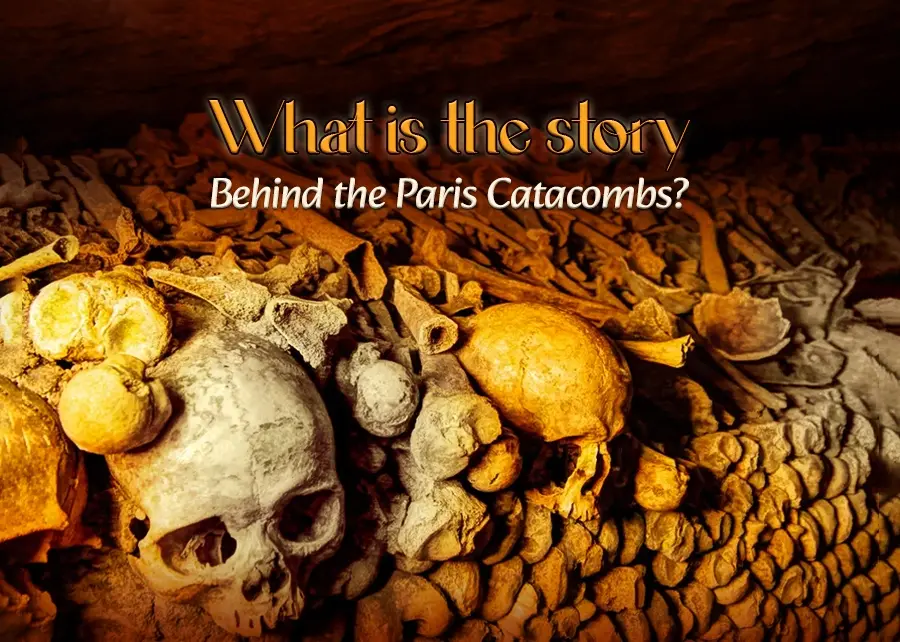Do you wish to know the background of the Paris Catacombs? If the answer is yes, then this blog post is for you.
Paris is known worldwide for its fantastic ambience, prominent destinations, and rich history. The Paris Catacombs provide a beneath-the-ground world with a darker, more mysterious story beneath its bustling streets. This labyrinth of tunnels, passageways ,chambers, and horrific displays featuring human keeps has attracted guests from anywhere in the world. This extensive discovery delves into the fascinating history of the Paris Catacombs, from the beginning to their historical significance.
Table of Contents
What is the cultural significance of The Paris Catacombs?
The Paris Catacombs are of significant cultural value, offering a unique witness to the city’s history. Initially quarries, they were transformed into an underground ossuary in the 18th century that continues to dwell in the skeletons of millions of people. In addition to their horrible allure, the cultural significance of Catacombs De Paris represents Parisian resilience, creative design, and an emotional connection to the past, making them a critical ethnic icon that resonates with visitors worldwide.
Are the Catacombs worth seeing?
Looking into the Catacombs is a remarkable and exciting experience that is an essential visit for those who love the past, and the present, and an inkling of the horrific.
History and Intrigue: The Paris Catacombs are more than just an aesthetic attraction; they are an actual artefact. At first historical quarries, these caverns rose to importance during the 18th century as a final resting place for millions of human skeletons. It’s a horrible yet fascinating visit through time.
Unique Experience: The Catacombs are ideal if you’re searching for an original and a little haunting experience. The shadowy tunnels are adorned with closely stacked bones, generating a particular environment. It’s a macabre creation of art.For More Information, visit Tours Travel Finder
Why were the Catacombs built ?
● The Catacombs were constructed initially for burial purposes.
● They provided a path to bury the expired underground, a common practice in ancient Rome and other civilizations.
● The Paris Catacombs were built to address the limited space for burials within the city limits.
● They provided a natural solution to congestion in cemeteries and the demand for more burial space.
● The Catacombs likewise offered a safe and secure atmosphere for the deceased’s stays, reducing the potential of tomb robbery.
● Many Catacombs have been linked with early Christian societies and were utilized as positions for Christian burials and ceremonies of faith.
● The Catacombs’ development allowed for planned and respectful burial practices following faith and cultural customs.
● Various Catacombs are additionally metaphorical and devotional, with detailed artwork and signs regarding Christianity and other faiths.
Historical Context
The Catacombs Origins
The Catacombs originally served as a hidden cemetery in ancient Rome. These subterranean mazes of tunnels, and the spaces were established as a practical answer to the city’s limited burial space. Traditional graveyards became overflowing as the city of Rome grew, prompting the emergence of the Catacombs as a response to the scarcity of burial space.
The Paris Catacombs took shape, launching in the second century AD and maintained for many generations. They were primarily utilized for interment, although they had additional cultural and spiritual functions. Some Catacombs have been connected with early Christian populations and served as burial sites and places for celebrations of religion. As a result, these beneath the ground complexes frequently contained Christian-themed artwork, carvings, and icons.
The Catacombs offered an adequate answer to ancient Rome’s burial needs but also helped maintain the town’s past and culture. They are now crucial archaeological sites providing details about old Roman burial habits and the earliest Christian faith.
The Catacombs During World War II:
During World War II, the catacombs acquired a new and unexpected role as the French Resistance’s refuge and secret seat. Hidden beneath the busy streets of Paris, these underground passages provided a haven for resistance fighters who tried to resist the Nazi occupation. The Paris catacombs served as a strategic hideout, allowing members of the resistance to plan and coordinate their activities beyond the reach of the occupying forces.
Interestingly, the catacombs also hid secrets of war, including hidden chambers and caches of weapons and supplies. Discovered long after the war ended, these secrets offer a fascinating insight into covert operations and the courage of those who risked their lives to resist oppression.
Modern-Day Significance Paris Catacombs facts:
The Catacombs endured their ancient significance and now suffer from effectiveness for Paris and the world. They are more than archaeological relics; they are an active memorial to the city’s multiple eras. The Catacombs, a popular destination for tourists, draw visitors from around the globe, allowing them to see the intricate tunnels and chapters that testify to the experience of Paris’s brutal past.
Additionally, the Catacombs indicate the French nation’s strength and resilient spirit, which faced adversity during World War II and developed stronger. They also raise issues related to the ongoing upkeep of historical sites and the delicate balance between celebrating the past and meeting current requirements.
The Paris Catacombs: A Reflection of History and Humanity:
In addition to their historical and cultural significance, the catacombs offer a unique lens through which to view history and contemplate the human condition. These underground chambers contain the echoes of countless lives and invite reflection on mortality, memory and the passage of time. They raise philosophical and ethical questions about the treatment of the deceased, the preservation of memory, and the intersection of the living and the dead.
The Paris catacombs, with their solemn beauty and the stories they contain, invite us to consider our place in a continuum of history and shared humanity that transcends time and space. They serve as a poignant reminder of humanity’s ongoing search for meaning and connection, making them a profound symbol of the past and present.
Top 5 Scary Facts about the Catacombs in Paris
● Beneath the City: The Catacombs sprawl beneath the streets of Paris, forming an underground labyrinth that stretches for miles.
● Millions of skeletons: The catacombs contain the remains of approximately six million people, creating a terrifying and haunting atmosphere.
● Artistic Arrangement: The bones in the catacombs are arranged in creative patterns and designs that showcase a terrifying form of organization.
● Secret Tunnels: The secret tunnels in the catacombs are off-limits to the public and add an air of mystery and intrigue to this underground world.
● Urban Exploration Hub: Although illegal, urban explorers often venture into restricted areas of the catacombs and create an underground community that adds mystery to this haunted location.
How Many Miles Is the Tunnel Under Paris map?
The underground network of catacombs stretches for vast distances beneath the streets of Paris, creating an underground labyrinth that is both awe-inspiring and disorienting. To quantify the extent of this labyrinth, we must consider the intricate network of tunnels and chambers that stretch for approximately 200 miles (or about 320 kilometres).
Originally limestone quarries, these tunnels have become a complex underground maze over the centuries. Navigating The Paris Catacombs can be daunting, consisting of narrow passageways, hidden chambers, and numerous intersections. Exploring this vast tunnel system is not for the faint of heart, and it is easy to get lost in the subterranean depths of this fascinating yet confusing underground world.
Paris Catacombs tour
Address: Catacombs aAddress: Catacombs is located at 1 Avenue du Colonel Henri Rol-Tanguy, 75014 Paris, France.
Public Transportation: Public transportation is the easiest way to reach the Catacombs. Take the Paris Metro and get off at Denfer-Rochereau station. The catacombs are just steps away from the parking lot.
Bus service: Various buses stop near the Catacombs, including lines 38, 68 and 88. Check the local bus schedule for the latest information.
By foot: If you want to explore on foot, you can reach the Catacombs from many points in the heart of Paris. Walk through the charming streets of the 14th arrondissement.
Taxi and Car Sharing: Taxi and car-sharing services are available in Paris. Enter the location of the catacombs into your favourite app or drag them to your site.
What is the best way to see the Paris Catacombs?
The best way to explore the Paris Catacombs is to book tickets in advance, take a guided tour, or use an audio guide for educational insights. Consider coming early in the morning or weekday to avoid the crowds, dress comfortably, and follow the photography rules. An exploration with online planning and on-site briefing ensures an unforgettable and rewarding visit to this historic underground site.
How many bodies are there in the Paris catacombs?
The sheer number of bodies buried in the Paris catacombs is genuinely staggering and raises the question of how this vast underground cemetery came to be. To understand this, we must delve into the history of Parisian burial practices.
Paris cemeteries were used for centuries for burials, but as the city grew, these burial grounds became overcrowded and unsanitary. In response, authorities moved remains from various cemeteries to abandoned limestone quarries beneath the city. This massive undertaking, which began in the late 18th century, involved moving the bones of millions of individuals into the catacombs of Paris, creating the underground ossuary we see today.
Conclusion
In short, hidden beneath the city’s grandeur, the Catacombs of Paris provide a journey into history, culture and horror. Tours Travel Finder will help you on this journey. Are you ready to embark on a thrilling road trip filled with excitement and research, and unforgettable memories? Look no further as Tours Travel Finder is here to be your ultimate travel companion, assisting you with making the best of each moment of your travels like never before! Their cultural significance, martial function and artistic components make them a fascinating experience.
Are any famous people buried in the Paris catacombs?
No, the catacombs of Paris usually hold the bones of unknown people. While some bones were moved from cemeteries such as the Cemetery of the Innocents during construction, notable people are not buried in the catacombs. The facility functions as an ossuary, storing the remains of millions of people while providing a unique historical and cultural experience.
When did France stop using the catacombs?
France officially stopped using catacombs for burial in the mid-19th century. The cessation of graves in the catacombs began in 1786 due to public health concerns and overcrowded cemeteries in Paris. The catacombs were eventually converted into an ossuary to solve the problem of overcrowded cemeteries.
What About the “Secret” Parisian Catacombs? Can I Visit Those?
Paris’s “secret” catacombs, often called the forbidden or illegal sections, are not open to the public. Entering these restricted areas is unlawful and dangerous and poses risks such as loss, exposure to hazardous conditions and potential legal consequences. Visiting authorized sections with tours or audio guides is recommended for safe and legal exploration of the catacombs.




